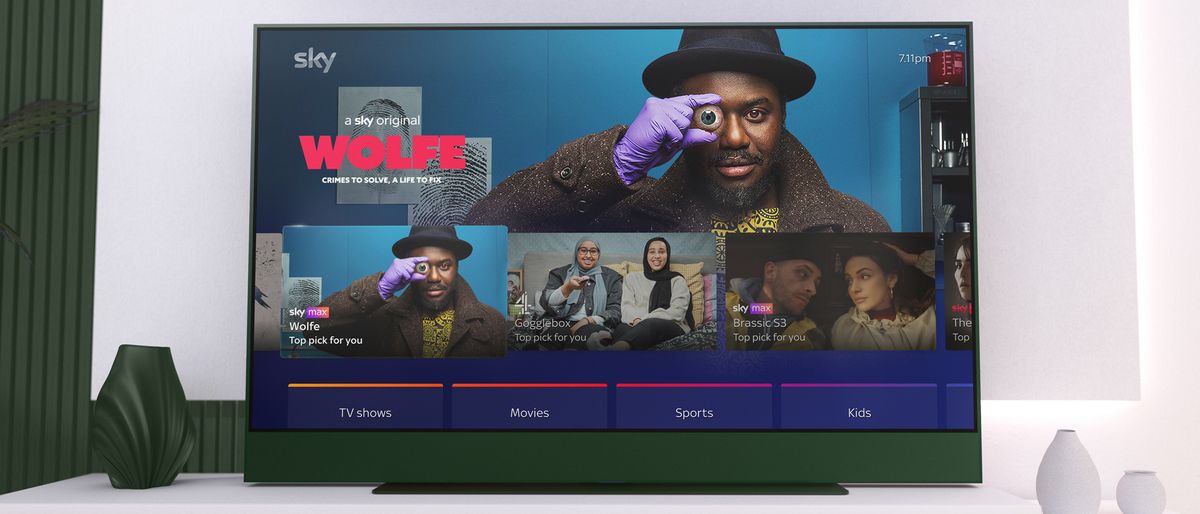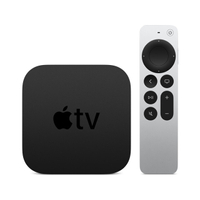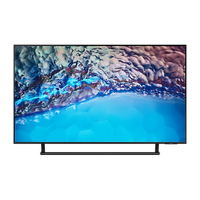TechRadar Verdict
Sky Glass will be just what many people have been waiting for—particularly if you're hankering for a 4K TV upgrade. It's technically ambitious, and the first all-streaming Sky TV package will be a boon to those denied a Sky dish. But to appreciate Sky Glass, you need to appreciate what it's not—and that's a straight replacement for Sky Q. It's not as channel rich and suffers from not having any recording functionality. Still, it offers a lot, and gets much right.
Pros
- +
All-in-one Sky viewing experience
- +
No dish required
Cons
- -
You need fast, reliable broadband
- -
No local storage
Why you can trust TechRadar
One-minute review
Sky Glass isn’t just a new TV from Sky. Instead, it’s a paradigm shift that’s set to shake up the whole premium TV market.
With Sky Glass, Sky brings you a 4K TV and an all-streaming alternative to Sky Q that dispenses with a standalone telly box and external dish aerial.
Sky Glass is a new offering we’ve not seen before: a premium TV service integrated into a bespoke flatscreen.
If you’ve been looking for an excuse to bag yourself a 4K TV upgrade, Sky Glass might be perfect for you. But Sky Glass isn’t a straight replacement for its subscription service, which you can read more about in our Sky Q review. For starters, it's not as channel rich and it suffers from not having any recording functionality.
Sizes: S (43-inches), M (55-inches), L (65-inches)
Display type: UHD Quantum Dot
Resolution: 3840 x 2160
Colour: Over 1 billion colours
HDR: Dolby Vision, HDR 10,HLG
Speakers: Dolby 3.1.2 output
Audio format: Dolby Atmos
Sound output: Up to 215 W
Delivery: WiFi or Ethernet
HD broadband speed required: 10Mbps
UHD broadband speed required: 25Mbps
HDMI: 3x HDMI 2.1, eARC and CEC supported
The set is a 4k QLED model that boasts decent local dimming backlight, Dolby Vision HDR, and a powerful six-speaker Dolby Atmos sound system.
Usability leans heavily on voice control, but don’t leave the traditional remote too far out of reach. The most contentious aspect of Sky Glass hangs on its everyday usability. That’s because, instead of 'Recording' content, you add it to a 'Playlist', which can be fed from several sources.
You shouldn’t have a problem watching most movies and TV shows, but you’ll need to be prepared for some restricted availability when it comes to watching—and some content can't be re-streamed after broadcast at all.
Overall, Sky Glass is an all-in-one premium TV package that opens the door to a whole new age of streaming TV. But do consider how you watch TV right now, and what features you absolutely need, before jumping in. Because such a different TV prospect is exciting but it might not be right for everyone.
If you're unsure, take a look at our best TV guide for our pick of the top alternatives. Otherwise, read on to find out more in our Sky Glass review below.
Sky Glass review: price and availability
- You get the TV as part of your monthly Sky package
- Available from £13 per month
Sky Glass launched in November 2021 and one of the many notable aspects of Glass is the pricing plan. You don't need to think about having to buy your Sky Glass TV like a regular flatscreen, as you get it as part of your monthly subscription, payment depending on the length of your contract and the Sky services you contract for.
Sky Glass is available in three screen sizes. There’s Small, Medium and Large (43-, 55- and 65-inch respectively) and five colours to choose from. The sizes are priced at £13, £17 and £21 per month, provided you opt for a 48-month contract.
Choose a shorter 24-month contract and they become correspondingly more expensive, at £26, £34 and £42 monthly.
This payment set-up makes it tricky to compare the Sky Glass TV to other rival sets. But if we go by those pay monthly prices above, that means the 55-inch set reviewed here has a retail equivalent cost of £816.
That makes it similar to some of the displays in our TVs under £1000 guide. Take a look at our Samsung BU8500 (55BU8500) review for a 55-inch set that's available for £799.
However, on top of that, you'll need to add your chosen Sky subscription channel package (prices vary, depending on whether you want to graze on movies and sports). There's an additional cost for 'Ultra HDR and Dolby Atmos' pack (we'd say that has to be a must), and multiroom.
Sky Glass doesn't require you to have Sky as a broadband provider. It'll work with any ISP.
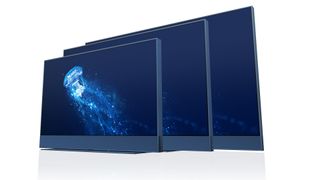
Sky Glass review: design
- Three HDMI inputs (with e-ARC support)
- Dolby Vision HDR and a Dolby Atmos sound system
- On-set voice control
Sky Glass doesn't look like an everyday flatscreen. Sky has made some bold choices when it comes to design—the set is deep with a flat back and up top, behind a metallic grille, are two upfiring height drivers.
The remaining speaker array faces forward behind a fabric panel, with the left and right output partially directed through side grilles.
The frame is aluminium, with no Sky logo. It's very minimalist, even chic. Adding to this interior friendly approach are the five colourways: Ocean Blue, Ceramic White, Racing Green, Dusky Pink and Anthracite Black.
As it happens, our review sample was the all-back edition, which to be honest, is the least interesting, but will probably be the most popular—black usually always outsells other colour options when it comes to home electronics.
Still, you can enliven things with a choice of customisable speaker fascias, to better match with your interior decor, or show an element of individuality.
Around the back are three HDMI inputs, HDMI2 with eARC. There's no support for 4K 120fps video playback or VRR. Sky Glass even lacks a dedicated low input lag Games mode. We measured input lag at 115.4ms (1080/60), which means the set holds limited appeal for serious gamers.
There is a terrestrial Freeview aerial input, although this is provided for back-up when your broadband goes down, and not everyday use.
The TV ships with a heavy metal pedestal stand that adds substantially to its imposing footprint, when viewed from the side.
Sky’s delivery team will handle the construction, and then take away all the packaging. If you want to wall mount, that's your call. It's hefty model, however, as our 55-incher tips the scales at 28kg.
The supplied controller builds on the basic Sky remote design, but is a little smaller and smoother in the hand than previous Sky remotes.
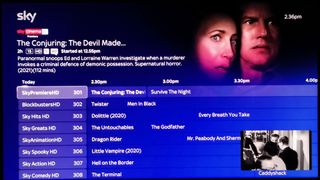
Sky Glass review: features
- Sky user interface
- Voice control
- Streaming apps
There may well be a multiverse out there, but you’d never know it using Sky Glass. Unlike the viewing experience on an Android or webOS TV (to name just two), this is a locked down Sky environment, and it's kinda cosy.
You don't need to venture outside this walled garden, because everything is provided.
The interface is recognisably Sky—consider it a cousin of Sky Q. Curated highlights, for Sky Max, Sky Atlantic and Sky Cinema, sit below a TV Guide rail offering what's on now across select channels.
Tab down and an App and Inputs rail offers up just that. Sky has assembled a solid assortment of streaming services here, 21 at launch, including Prime Video, Netflix, Disney+, BBC iPlayer, BBC sounds, All4, ITVhub, YouTube, discovery+ and STV player. More recently others have been added, like Apple TV Plus.
There are also Peloton and Fiit wellness apps, music streaming service Spotify, and an assortment of casual games.
But with no local storage, what you don't have is the ability to record shows to a hard drive, for playback as and when. This is the single biggest adjustment when moving from Sky Q to Sky Glass.
Instead you add to a Playlist (there's only one, no Profiles on offer here). This can be done via an 'Add Show' button on the programme summary page, or via the '+' button on the remote.
For the most part, this works well. Shows are available in your Play-listing and they stream from a 'Cloud DVR'.
However, they may also come via a standard catch-up TV app, which puts you at the mercy of the third party player. There is also some content which simply can't be added to the Playlist at all, like channels from BT Sport - this basically makes them 'unrecordable'.
Another TV staple missing is headphone support, for late night or private listening. Not only is there no Bluetooth headphone option, there's no wired 3.5mm headphone jack output. This is just plain bizarre.
The set does has Bluetooth, but it's just for the remote control.
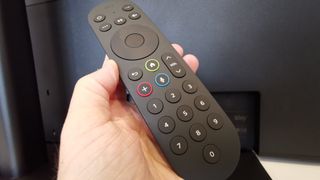
It's important to note that the channel choice between Sky Q and Sky Glass is not exactly the same. We're a big fan of NHK, but it's AWOL on Sky Glass.
The set has a Wake using Motion mode, which can be activated in the menu. The idea is it'll automatically turn on during daytime and evening when motion is detected in the room. When no motion is detected for an hour, the set turns off.
For whatever reason, our sample didn't want to wake up, even if you dance around in front of it (we tried), but it does auto nod off.
It'll turn on to a spoken "Hello Sky" command. This wake word has to be used before any voice command, so say "Hello Sky. BBC News" if you want to hands-free switch to the news channel. The set also acknowledges "Hi Sky," but not "Yo Sky".
If you want Sky Glass in additional rooms, you'll need to add a Sky Stream puck to your package (it's another tenner). Unlike the Sky Q Mini, this doesn't rely on a connection with the Sky Glass screen, and it can serve you 4k UHD content.
That's because it's a completely autonomous Sky streamer. It offers the same interface and feature set as the Sky Glass screen, and you can connect it to any TV.
You can't buy a Sky Stream Puck separately; it's only available as a Sky Glass accessory. A Puck was not supplied for review.
Sky Glass review: picture quality
- Dolby Vision HDR
- Auto Picture mode
In many respects, the audio visual performance of Sky Glass seems somehow less significant that the overall user experience, but it's obviously central to the overall package proposition.
After all, once in, you can't swap it after a year for something new. It has to deliver—and up to a point, Sky Glass does. But there are caveats.
The Sky Glass screen has a number of attractive attributes (our review sample is the Medium 55-incher): QLED colour, 'Intelligent Zonal' local dimming, and Auto picture management.
While it offers options, it's clear that Sky doesn't expect users to dig around in the Settings menu and manually adjust picture parameters.
The default viewing mode is Auto. There are dedicated presents - Entertainment, Movie, Sport, etc - but each one comes with a nag to return to Auto. Actually we were hard pressed to tell the difference between these presets.
For the bulk of this audition, we did what most Sky Glass owners will do, and that’s stay on autopilot.
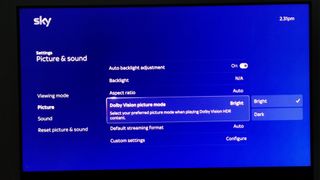
There's also a Custom setting, with individual control of contrast, sharpness, brightness, and saturation. There are two Dolby Vision HDR settings, Bright and Dark. The former is our recommended option.
An Auto backlight adjustment manages settings based on ambient room lighting.
The screen has pleasing average picture brightness. However, it’s not the most dynamic HDR performer. We measured peak HDR brightness at 425 nits, with a 10 per cent measurement window.
But this doesn’t tell the whole picture. During our audition period, Sky dropped some new firmware which specifically gives HLG HDR a boost, offering a welcome lift to live Sky Sports coverage.
For the best HDR performance, with real world content, we would suggest turning the Auto Backlight Adjustment off, and running contrast at around 90 on the slider.
Colour vibrancy is high, with crowd-pleasing candy colours, and fine detail performance is excellent.
Sky Glass review: sound performance
- Dolby Atmos audio
- 215W stereo
The Sky Glass audio system significantly outperforms rival mid-range LED models both in terms of scale and power, the six-speaker 3.1.2 array creating a wall of sound that’s both wide and high. It's a lot of fun to listen to.
With Dolby Atmos content, there's no profound sense of overhanging audio, but you do get physical imposition with heft and clarity.
Movie audio is impressive. The set has a solid mid-bass as well as quite toppy treble. While it'll play loud, the set is at its best reigned in a tad. This prevents the highs from sounding too... glassy.
The idea is to negate the need for a soundbar, and for Sky Glass users it does the job nicely.
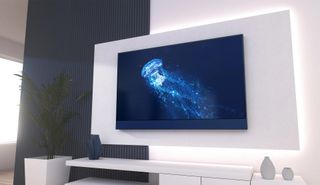
Conclusion
Sky has created an IPTV platform that's more nuanced and versatile than any streaming service currently available. It offers lots of choice, including a huge range of curated premium channels and top notch streaming apps.
Its pay monthly package is also bound to appeal to anyone who wants a new 4K TV but has always been put off by handing over such a huge amount of money.
In terms of performance, this isn't the best TV that's available. The AV performance is comparable to rival upper budget/mid-range models, rather than premium screens from the likes of Sony, LG, Panasonic and Samsung.
You'll also need to make sure your broadband speeds are up to scratch, as Sky recommends a minimum of 10Mbps for HD and 25MBps for UHD content. Which means if you don’t have sufficient bandwidth the picture will periodically freeze.
But if you want to enjoy the Sky experience without the need for a dish, then the Sky Glass TV is a great all-in-one entertainment solution.
Also consider...
If your Sky Glass review has you considering other options, then check out three all-rounder TVs that would make fantastic alternative picks below.
Samsung The Frame QLED 4K TV (2022)
It's hard to recommend direct competitors to Sky Glass considering it's not just a TV. But if it's the style points of the Glass you're after, then take a look at Samsung's latest version of The Frame (2022), its stylish TV with a lovely design and arty features.
Read our full Samsung The Frame QLED 4K TV (2022) review
Apple TV 4K (2021)
No, this isn't a TV rival. But do you need a new one? If you were considering the Sky Glass because you wanted Sky's programming, consider if you're better suited to a streaming device. Like the Apple TV 4K (2021), which can play 4K video in HDR and Dolby Vision, and supports high-frame-rate HDR to make fast action and sports look smooth and clear
Read our full Apple TV 4K (2021) review
Samsung BU8500 (55BU8500)
For a big, smart, all-rounder TV check out the BU8500 from Samsung. Released in summer 2022, it's a very nice TV indeed when you balance the price, specification and screen-size ratio. It gives you comprehensive smart TV support and great 4K picture quality for not much money.
Read our full Samsung BU8500 (55BU8500) review
- First reviewed in November 2021
Steve has been writing about AV and home cinema since the dawn of time, or more accurately, since the glory days of VHS and Betamax. He has strong opinions on the latest TV technology, Hi-Fi and Blu-ray/media players, and likes nothing better than to crank up his ludicrously powerful home theatre system to binge-watch TV shows.
Arsenal vs Man Utd live stream: how to watch FA Cup third round game online

MSI launches two Cubi NUC AI mini PCs but I am still waiting for one with a Thunderbolt 5 port

This modern cassette player with Bluetooth (and matching retro wireless headphones) might've been my favorite music experience at CES 2025
